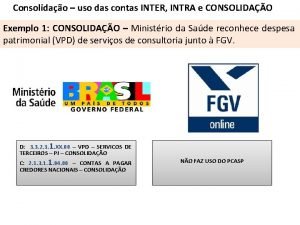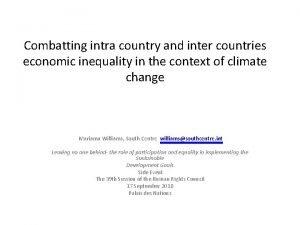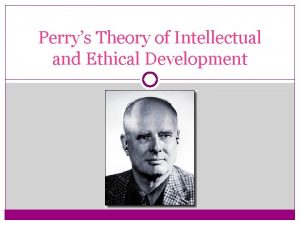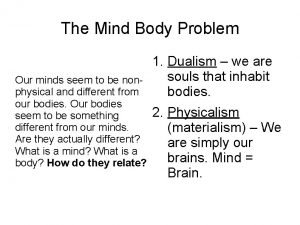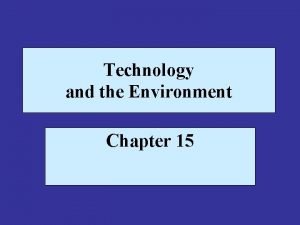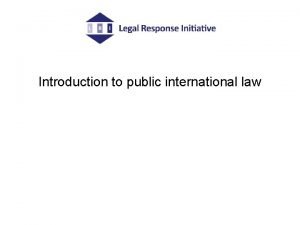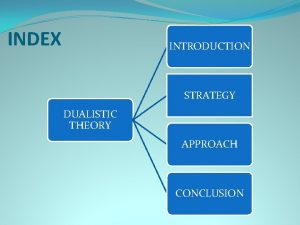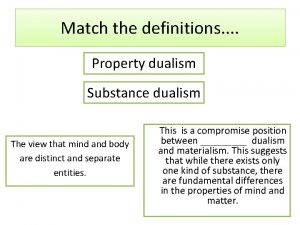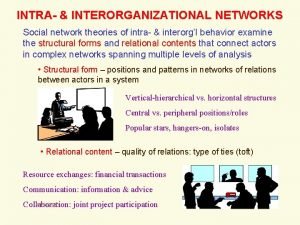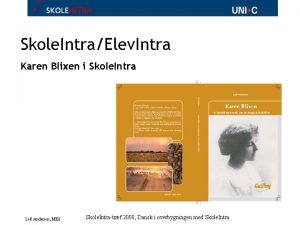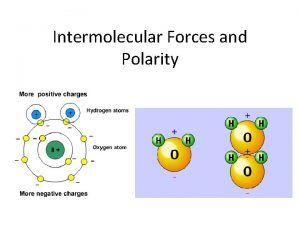Lecture3 Dualism Inter and Intra Schism Perspectives in
























- Slides: 24

Lecture-3 Dualism/ Inter and Intra/ Schism Perspectives in Regional Planning Department of City & Regional Planning Lahore College for Women University, Lahore. Saba Islam

Inter and Intra Regional Perspectives in RDP For a convenient understanding, theories explaining development in spatial context may be divided into two categories; those which emphasized the play of intra-regional factors leading to development or underdevelopment, and those which stressed the role of spatial interaction between developed and underdeveloped regions, largely detrimental to the interest of the latter. Modernization Theory • Intra regional perspective Dependency Theory • Inter regional perspective

1. Intra Regional Perspectives Theories in this group assign importance to factors relating to natural resources, technical advancement, and social institutions that resources, technical advancement, and social institutions hindered or accelerated the process of development. Nurkse’s (1958) ‘vicious circle theory’ presented an attractive idea that underdeveloped countries were trapped in a series of interlocking problems of poverty and stagnation. The starting point was poverty, which was an insurmountable obstacle to development. If this thesis was valid then it would be difficult to understand as how the presently developed countries, which were not so have made advancement. Low real income Low productivity Low rate of capital formation Low savings Low buying power Low demand Low investment

1. Intra Regional Perspectives Boeke Spiralism Boeke (1953) attributed underdevelopment in the oriental world to limited needs, backward sloping supply curves of effort and risk taking, and an absence of profit seeking attitude. He stressed that the eastern society was molded by fatalism and resignation. His gloomy analysis was rightly questioned by a number of scholars including Lewis, Baner, and Yarney. Mc. Clelland (1961) found a high association between a country’s level of achievement motivation and rate of its economic development.

1. Intra Regional Perspectives Hagen & Hoselitz Hagen (1962) postulated ‘authoritarian theory’ holding feudal bringing up of the children responsible for the economic development of a country, In his ‘theory of social deviance’, Hoselitz (1960) assigned key role to ‘deviants’ in development. He defined deviants as the one who break traditions, adopt innovations and thereby accelerate the process of transformation from underdevelopment to development. George (1981) Accused the local elites of the third world countries as the real cause of underdevelopment, in postcolonial situation. According to her these elites remained the natural friends of western developed countries and exploited the native poor for their own vested interest and retarded the process of development.

1. Intra Regional Perspectives Berry (1969) Underlined the development role of integrated urban hierarchy in which innovations filtered down from cities to towns and from both to their surrounding countryside…Cities as Engine of Growth Llyod and Dicken (1972) observed that definable hierarchy of central places was a characteristic feature of an economically developed region.

1. Intra Regional Perspectives Johnson (1965) He associated development inequality with varying access to urban market. Some other theories described the sequence of development phases, and viewed the existing gap between developed and developing countries as a matter of time lag. The chief exponents of this historical thesis were German scholars namely List, Brune, Hilderbrand, Bucher, Schmoller and Sombart Rostow (1960) Borrowing an analogy from the flight of an airplane he noted five stages in economic transformation of a capitalist society; traditional society, precondition for take-off, takeoff, drive to maturity, and age of High Mass consumption. The different countries of the world could be assigned to a particular stage a given point in time.


Tools/Techniques for Intra regional analysis Theories reviewed above explained development and underdevelopment in an area and regional disparities accruing out of them through the intrinsic conditions. Role of social, psychological and spatial factors were emphasized. The historical perspective was strong in most of them. # Intra regional tools Principal analytical questions 1 Intra regional compendium What are the comparative socio-economic profile of the regions subunits? 2 Income measures What are the levels of different types of income in the subunits of the region 3 Income and product accounts What are the levels of income in different parts of the region in association with their different patterns of production 4 Input-output analysis What are the inter industry linkages and their multiplier effects among different subunits of the region 5 Mix and share analysis How has the changing economic composition of the area been reflected in different industries in the subunits of the region

Tools/methods/Techniques for Intra regional analysis # Intra regional tools Principal analytical questions 6 Location Quotient What are the comparative levels of concentration in selected characteristics or activities among different subunits of the region 7 Indexes of concentration and association To what degree are selected activities or characteristics geographically concentrated in the region in comparison with selected attributes of regions subunits 8 General interaction studies What are the major types of trade interactions among subunits of the region, and what do they imply about regions economic growth potentials 9 Extended commodity trade system analysis What are the marketing chains within the region for important area commodities, and how well do specific links in these chains operate 10 Income accrual analysis To what extent and how do export sales translate into greater volumes of income accruing in the various subunits of the region

Tools/methods/Techniques for Intra regional analysis # Intra regional tools Principal analytical questions 11 Resource hazard inventory What are the distribution of key natural resources and hazards, and their implications in the region? 12 Resource suitability classification What are the suitability of natural resources in different parts of the region? 13 Resource depletability analysis What are the comparative depletability of major natural resources in different parts of the region? 14 Resources sector reports What are the relationships between major sectors of economic activity and key natural resources at different places in the region? 15 User origin analysis Where do people served by different socioeconomic functions of towns in the area reside?

Tools/methods/techniques for Intra regional analysis # Intra regional tools Principal analytical questions 16 Settlement typology scheme What are the pattern of dominant economic functions among towns in the regions settlement system? 17 Settlement scalogram analysis What are the hierarchical pattern of socioeconomic functions in the regions settlement system? 18 Market center studies What are the major trade functions of the regions markets? What are the markets for those functions? and How are regions market centers linked through trade?

2. Inter Regional Perspectives Theories emphasizing spatial interaction The second group of theories, with spatial interaction as the main analytical framework, viewed development and underdevelopment as the two facets of the same coin. Development in one region was at the cost of underdevelopment in some other due to operation of ‘backwash effect’. Western colonial power exploited the third world through direct control during the colonial period and through tied trade and by extension of their aid and model of development in postcolonial period. The developed world created third world and third world created fourth world in their own countries by the greed of elites, arrogance of bureaucrats, hypocrisy of politicians and of western trained pseudo planners and academicians.


2. Inter Regional Perspectives In just contrast some theories, such as ‘Growth Pole’ of Perroux, Boudville and Richardson ‘Spatial Diffusion’ of Haggerstrand (1967): and ‘Growth Foci’ of Misra et al. (1976) gave due recognition to spread effects of development. These theories envisaged that if metropolitan development is sustained at high level, differences between center and periphery may be eliminated, as the economic dynamism of the major cities trickle down to smaller places and ultimately into most tradition bound peripheral areas The spatial interaction theories derived their meaning from three different context of space economy; 1. free market mechanism 2. colonial setting and 3. neocolonial situation

2. Inter Regional Perspectives 1. Free market mechanism was always biased in favor of development areas. ‘Core-Periphery Theory’ by Friedmann (1966), ‘Circular and Cumulative Causation Theory’ by Myrdal (1957) represented this context.

2. Inter Regional Perspectives 2. The second was Colonial setting in which the imperial powers flourished at the cost of their colonies siphoning off the latter’s resources. This was well illustrated by colonial dependency theory of Kundu and Raza (1982), and in the writing of Marxist scholars such as Davey (1975) and Pavlov e. t all, (1975). 3. The third context was Postcolonial situation in which the newly independent developing countries remained dependent on developed countries and found it difficult to extricate themselves from the network of exploitation. Amin (1974) called this process ‘Peripheral Capitalism’ and Santos used the term ‘dependent capitalism’ (1978). The other exponents of this idea were Baram (1970), Frank (1972), Fanon (1963) and Potekin (1962).

Tools/methods/Techniques for Inter regional analysis # Inter regional tools Principal analytical questions 1 Area compendium What is the overall socioeconomic profile of the region? 2 Sectoral analysis What are the salient characteristics and local economic roles of regions sectors? 3 Income measures What are the levels of different types of income in the area? 4 Income and product accounts What is the value of production in the area and how is this value expressed as regions income? 5 Economic base analysis What is the general relationship between area export sales and the total employment in the area/region?

Tools/methods/Techniques for Inter regional analysis # Inter regional tools Principal analytical questions 6 Input output analysis What are the natures and economic effects of inter industry production linkages in the region? 7 Production linkage studies What are the natures of major forward and backward production linkages across the borders of the region? 8 Flow studies What volumes of goods flow to and from markets outside the region? 9 Mix and share analysis How has the industry makeup of the area economy affected levels of employment in the region? 10 Location Quotient How specialized is the area economy, relative to the country, in certain activities normally associated with specific characteristics of the region?

Hypotheses on Regional Disparities On the basis of study of trend and pattern of regional disparities in the development of different regions and various countries four hypotheses were extended: The first hypothesis was Spatial Convergence based on development experiences of the western developed countries. It was stated that regional disparities tend to lessen with the process of development. The hypothesis found its support in the ‘Spread and Backwash Theory’ of Myrdal (1957), ‘Trickle Down and Polarization Effect Theory’ of Hirschman (1958), Urban Hierarchy Thesis for Development Innovation of Berry (1969), Growth Pole Theory of Perroux, Boudville and Richardson, Spatial Diffusion of Haggerstrand (1967) and Growth Foci of Misra et al. , (1976).

Hypothesis on regional disparities The spatial convergence hypothesis was falsified in case of third world developing countries where regional disparities increased with the process of development. In these countries the Self-Perpetuation Hypothesis; the second hypothesis was based on the findings of Latin American and African situation. The thesis found its support in colonial and neocolonial dependency theory of Frank (1972), Amin (1974) and Kundu and Raza (1982). Additional point that favored this hypothesis was development planning based on the principle of techno-economic efficiency and demonstration effort. In the capital scarce third world countries with the meager development resources were invested in economically efficient regions that accelerated the regional disparities.

Hypothesis on regional disparities The third hypothesis, which was Concentration Cycle Hypothesis, is a synthesis of convergence and divergence hypothesis. It is well known as Inverted ‘U’ Shape Hypothesis of Williamson (1965). It denotes that regional disparities increases in the beginning of development process remain constant for some time and ultimately decrease with the process of development. It may be true in case of very long duration of time. However, the experience of developing countries showed that there was no visible sign for the decrease of regional disparities in these countries. All these facts lead to fourth hypothesis that there is no association between development and regional disparities. In short it may be stated as ‘no trade-off hypothesis. ’

Role of Regional Planning The main purpose of regional planning is to ensure optimal utilization of space and optimal distribution pattern of human activities over the space. To achieve this, it plays either. 1. Passive or indicative role…Intra regional is to point out how the sectoral investments decision can be integrated at the regional level and the advantages there of. 2. Active or imperative role…. Inter regional…. Regionalism is formulating and then implementing measures to assist the growth of certain regions, while restraining the growth of others.

? What is Schism
 Intra-elite schism
Intra-elite schism How to develop intrapersonal skills
How to develop intrapersonal skills Inter and intra personal skills
Inter and intra personal skills Intrapersonal skill adalah
Intrapersonal skill adalah Inter intra extra
Inter intra extra Intra versus inter
Intra versus inter Intra country vs inter country
Intra country vs inter country Difference between monism and dualism in international law
Difference between monism and dualism in international law Perry’s theory of intellectual and ethical development
Perry’s theory of intellectual and ethical development What was the great schism?
What was the great schism? Skew and schism
Skew and schism Cartesian mind body dualism
Cartesian mind body dualism Who is this
Who is this Substance dualism
Substance dualism Rene descartes monism
Rene descartes monism Descartes conceivability argument
Descartes conceivability argument Cartesian mind body dualism
Cartesian mind body dualism Technological dualism
Technological dualism Substance dualism
Substance dualism Substance dualism
Substance dualism International law definition
International law definition Technological dualism
Technological dualism Thomas nagel dualist
Thomas nagel dualist Indivisibility argument for substance dualism
Indivisibility argument for substance dualism Princess elizabeth's objection to dualism
Princess elizabeth's objection to dualism




